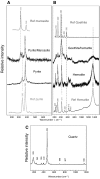Arsenic and high affinity phosphate uptake gene distribution in shallow submarine hydrothermal sediments
- PMID: 30956374
- PMCID: PMC6413627
- DOI: 10.1007/s10533-018-0500-8
Arsenic and high affinity phosphate uptake gene distribution in shallow submarine hydrothermal sediments
Abstract
The toxicity of arsenic (As) towards life on Earth is apparent in the dense distribution of genes associated with As detoxification across the tree of life. The ability to defend against As is particularly vital for survival in As-rich shallow submarine hydrothermal ecosystems along the Hellenic Volcanic Arc (HVA), where life is exposed to hydrothermal fluids containing up to 3000 times more As than present in seawater. We propose that the removal of dissolved As and phosphorus (P) by sulfide and Fe(III)(oxyhydr)oxide minerals during sediment-seawater interaction, produces nutrient-deficient porewaters containing < 2.0 ppb P. The porewater arsenite-As(III) to arsenate-As(V) ratios, combined with sulfide concentration in the sediment and/or porewater, suggest a hydrothermally-induced seafloor redox gradient. This gradient overlaps with changing high affinity phosphate uptake gene abundance. High affinity phosphate uptake and As cycling genes are depleted in the sulfide-rich settings, relative to the more oxidizing habitats where mainly Fe(III)(oxyhydr)oxides are precipitated. In addition, a habitat-wide low As-respiring and As-oxidizing gene content relative to As resistance gene richness, suggests that As detoxification is prioritized over metabolic As cycling in the sediments. Collectively, the data point to redox control on Fe and S mineralization as a decisive factor in the regulation of high affinity phosphate uptake and As cycling gene content in shallow submarine hydrothermal ecosystems along the HVA.
Keywords: Arsenic biogeochemistry; Arsenic speciation; Hydrothermal activity; Phosphate biogeochemistry.
Figures









References
-
- Breuer C, Pichler T. Arsenic in marine hydrothermal fluids. Chem Geol. 2013;348:2–14. doi: 10.1016/j.chemgeo.2012.10.044. - DOI
LinkOut - more resources
Full Text Sources
Research Materials
